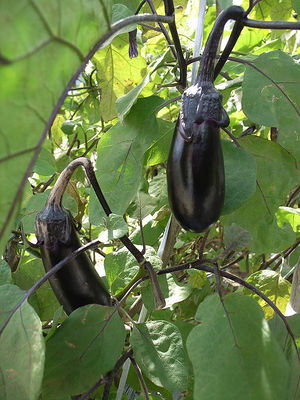Eggplant
Eggplant (Solanum melongena), known in some parts of the world as aubergine, is a plant in the nightshade family. Eggplant is grown for its hard, purple-skinned fruit which grows on often spiny vines. The leaves and roots are also sometimes eaten for their health benefits. Originally from the tropics and subtropical regions, this is a warm-weather perennial. In temperate climates, eggplant is typically grown as an annual plant, and allowed to die when the weather turns cold. In this case, they typically produce ripe fruit in mid to later summer.[1]
Health
Eggplant fruit is not especially rich in one nutrient; instead, it offers a wide variety of nutrients. It is also a powerful antioxidant. Among the nutrients in eggplant are folate, potassium and manganese, as well as vitamins C, K, and B6, phosphorus, copper, thiamine, niacin, magnesium, and pantothenic acid. Scientists have found that among the different varieties of eggplant, the Black Magic variety has almost three times the nutrients of other types.[2]
Possible medical uses
It has been found by researchers that nightshade fruits including eggplant demonstrate antiproliferative activities against human colon and liver cancer cells[3] Eggplant also seems to help fight fibrosarcoma (soft tissue-related) cell invasion.[2]
A sort of tonic sometimes made using the leaves and roots of eggplant is also sometimes used to help with throat and stomach troubles, asthma, skin diseases, rheumatism, inflammation, intestinal hemorrhages, foot pain, coughs, anorexia, and even toothache.[2]
